Key takeaways:
- Selective mutism is an anxiety disorder that prevents children from speaking in certain situations, leading to isolation and communication challenges.
- Peer relationships are crucial for children with selective mutism, helping to build confidence and encourage expression.
- Creating supportive environments and opportunities for interaction, such as small group activities and role-playing, can help children overcome communication barriers.
- Inclusivity can be fostered by valuing diverse communication styles and establishing ground rules for respectful discussions.
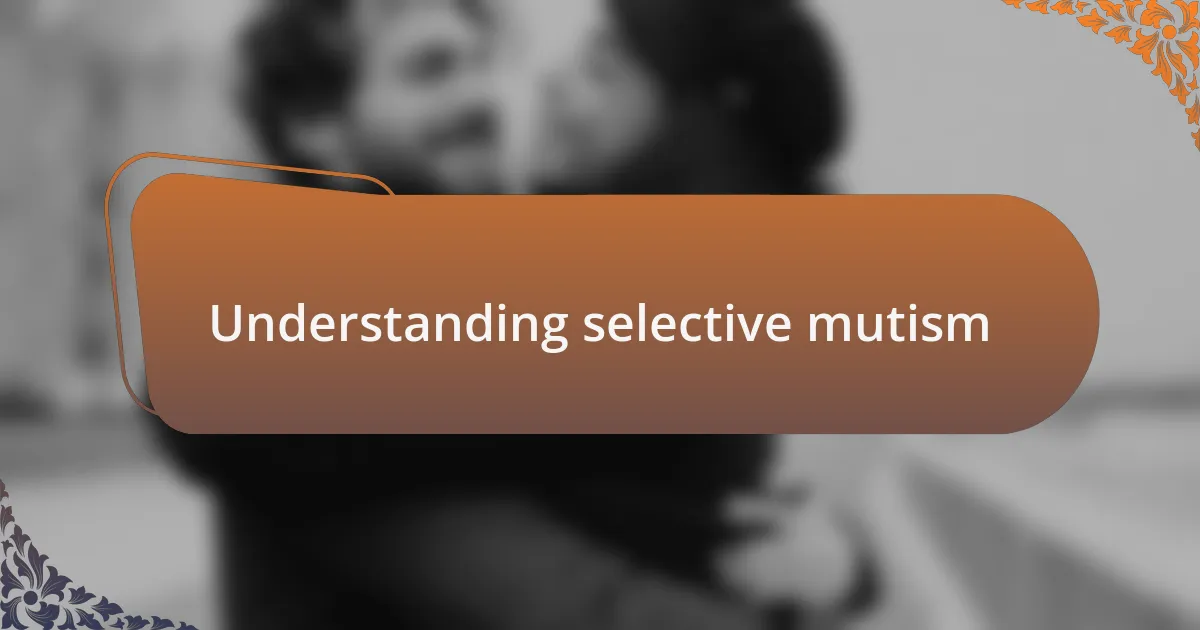
Understanding selective mutism
Selective mutism is a complex anxiety disorder that primarily affects children, causing them to be unable to speak in certain social situations, despite having the ability to speak in others, like at home. I still remember how my younger cousin would light up and chatter away at family gatherings, yet she would stand silent in the classroom, her eyes wide with apprehension. Have you ever seen someone freeze in a moment that demands their voice? It’s heart-wrenching—and a stark reminder of the invisible battles these children face.
Often misunderstood as mere shyness, this condition is deeply rooted in anxiety. I recall a time when I attempted to encourage my cousin to speak to a new friend. Even the simplest prompt felt like climbing a mountain to her. Can you imagine feeling so overwhelmed that words simply escape you? It’s not about defiance; it’s about fear that can seem insurmountable.
Furthermore, the social implications of selective mutism go beyond just communication difficulties. I know from experience that it can isolate children from their peers, creating a cycle of anxiety and withdrawal. It raises an important question: how can we create supportive environments that encourage these children to express themselves? Understanding the nuances of selective mutism is essential for fostering empathy and finding ways to help those who experience its challenges navigate their world.
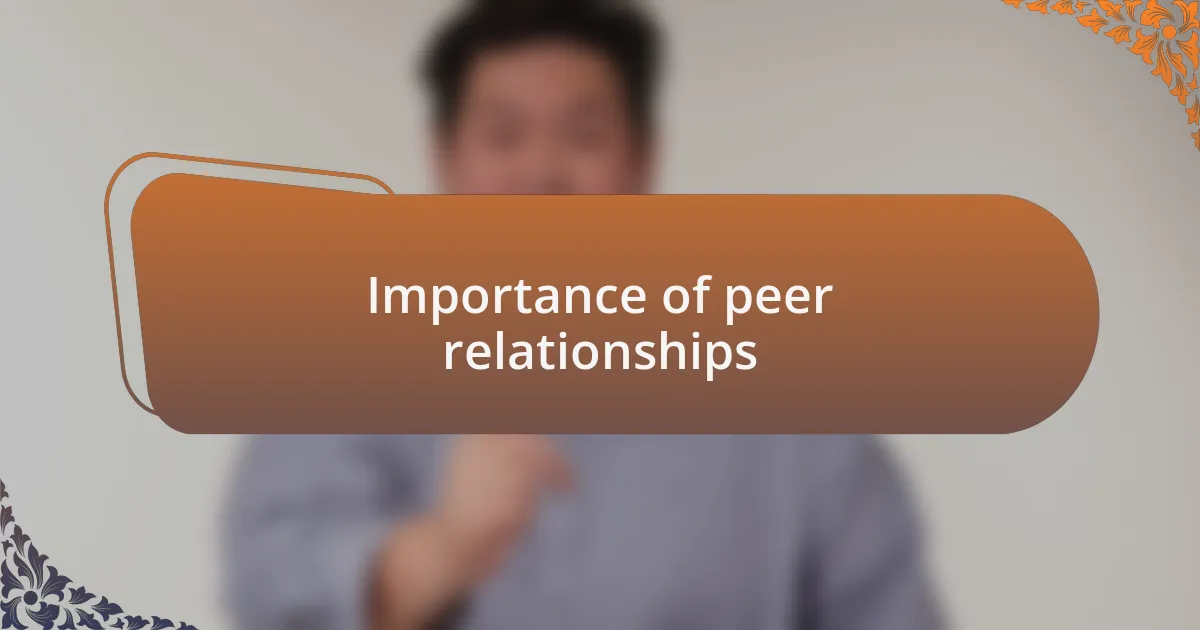
Importance of peer relationships
Peer relationships play a vital role in the emotional and social development of children, especially for those experiencing selective mutism. I remember the first time I saw my shy neighbor connect with another child over a shared interest in dinosaurs. That moment of laughter and excitement made me realize how relationships can bridge the gap created by anxiety. Have you ever seen how a simple connection can encourage a child to express themselves more freely?
Engaging with peers can help build confidence in children with selective mutism. I once watched a friend’s daughter shyly join a small group during a craft activity; with gentle encouragement, her artistic skills shone through, sparking conversations she wouldn’t have initiated otherwise. It’s fascinating how shared experiences can create a safe space for children to find their voices. When they feel accepted and understood, the weight of their anxiety seems to lighten, if only just a little.
Moreover, forming friendships can provide a sense of belonging that is crucial for mental well-being. I recall a time when I made an effort to include another classmate who often struggled to join in. For those moments when they felt invisible, just being acknowledged can make a world of difference. So, how can we foster these connections in our own communities? By encouraging inclusive play and understanding, we can help these children take steps toward overcoming their struggles.
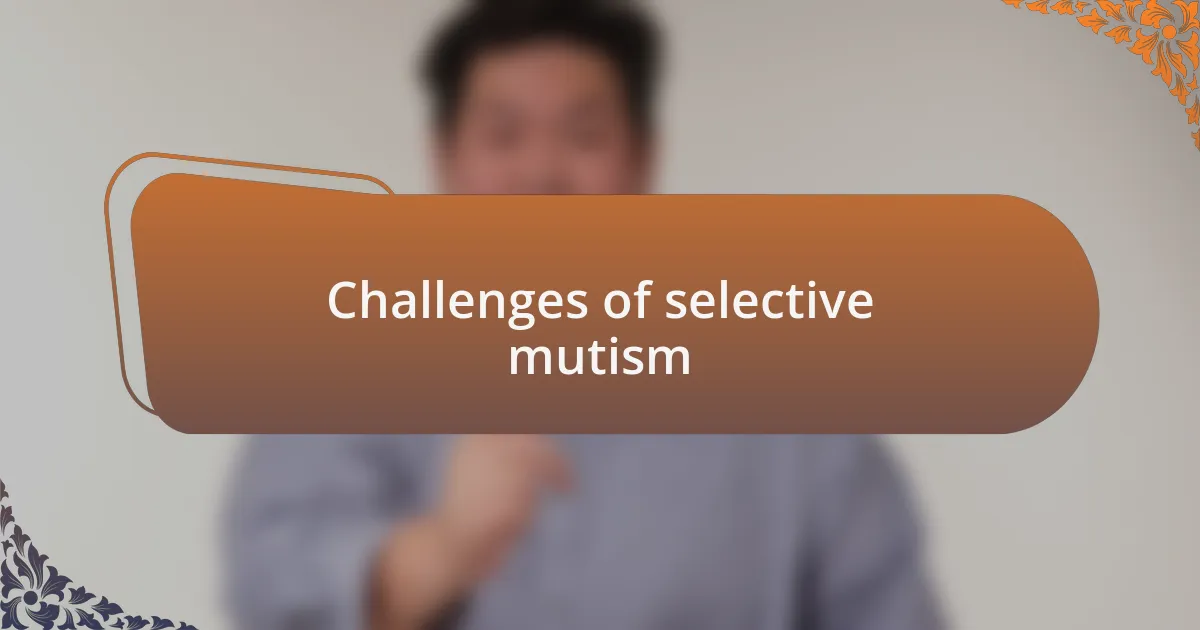
Challenges of selective mutism
Selective mutism presents a unique set of challenges, particularly in social situations where communication is key. I remember attending a birthday party where a child with selective mutism stood quietly in the corner, visibly anxious while everyone else was laughing and playing. It became clear to me how isolating these moments can be—participating in fun activities can feel daunting when speaking out is a struggle. Have you ever felt the pressure to join in but found it hard to take that first step?
Navigating peer interactions can be incredibly stressful for children with selective mutism. I once counseled a young girl who struggled to speak to her classmates during lunch. Despite being surrounded by friends, she felt trapped in her silence, as if her thoughts were locked away. It’s heartbreaking to witness how internal fears can overshadow opportunities to connect and enjoy the company of others. What can we do to help these children feel more at ease in such settings?
Furthermore, the fear of judgment can prevent children from forming meaningful relationships. I recall a boy who loved soccer but hesitated to join a team because he feared being critiqued. The thought of not being heard—or worse, being misunderstood—can deter them from engaging fully with their peers. It’s essential to create environments where children feel safe and supported, allowing their voices to emerge naturally. What strategies have you seen work well in fostering confidence in children facing similar challenges?
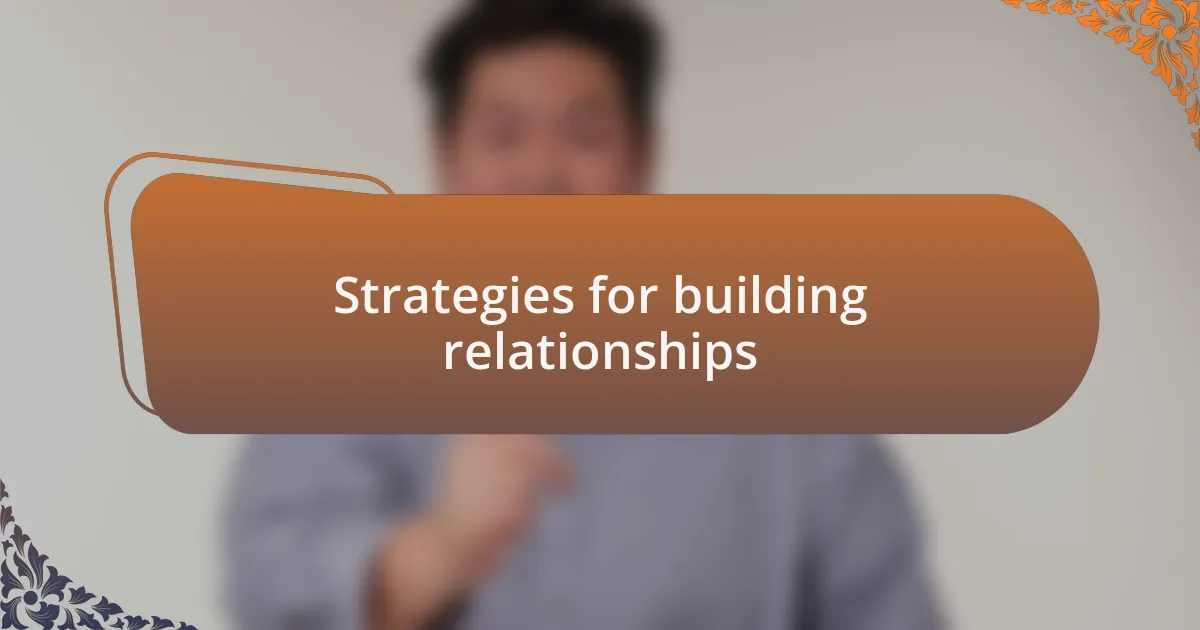
Strategies for building relationships
Building relationships requires intentionality, especially for children grappling with selective mutism. I remember when my niece started a new school and felt overwhelmed. To ease her transition, I suggested she invite a classmate over for a casual movie night. This low-pressure setting not only allowed her to interact without the stress of a crowded environment but also fostered a budding friendship where she could express herself more comfortably. Have you thought about how simple invitations can open doors for connection?
Creating structured opportunities for interaction can also be beneficial. When I volunteered at a community center, I often observed shy children thriving in small group activities like art projects. These experiences offered them safe spaces to share ideas and collaborate without the pressure of direct conversation. I was struck by how much more at ease they became when working side by side rather than facing each other in a traditional social setting. How can we incorporate similar approaches in our everyday lives?
Lastly, I find that involving parents and caregivers in this journey is crucial. One time, a parent of a child with selective mutism shared their success in role-playing conversations at home. This practice not only built the child’s confidence but also bridged the communication gap before engaging with peers. By working together, we can create a supportive network that encourages children to take small steps towards verbal interaction. What role do you think families play in fostering these connections?
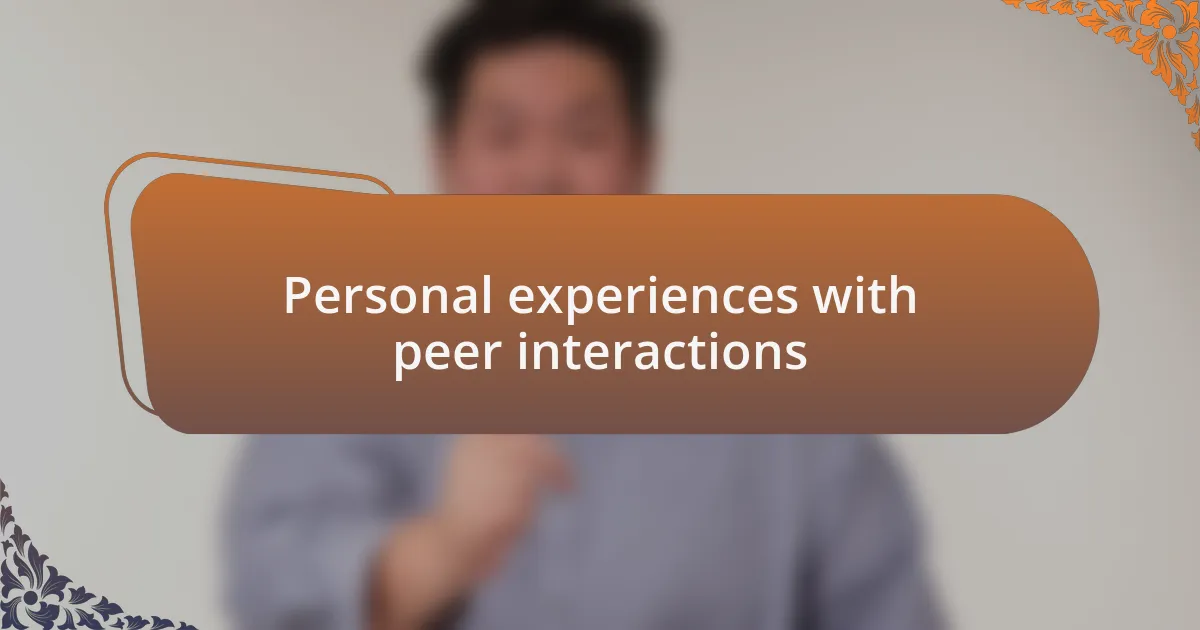
Personal experiences with peer interactions
Navigating peer interactions has always felt like walking a tightrope for me, balancing the desire to connect with the fear of judgment. One vivid memory stands out: during a group project in high school, I struggled to voice my ideas. I can still remember the warmth of my partner’s patience as they encouraged me to jot down my thoughts instead of speaking them aloud. That small act made a huge difference and taught me the value of understanding in friendships. How can we encourage that same kind of patience in our own circles?
As I’ve reflected on my interactions over the years, I’ve found that non-verbal communication often speaks louder than words. During a summer camp a few years back, I noticed that when I engaged in activities like team sports or crafts, my peers were more willing to include me, even without conversation. It felt liberating to bond over shared experiences where the focus was on collaboration rather than verbal engagement. Isn’t it fascinating how connection can transcend words?
I also can’t forget those moments when friendships blossomed unexpectedly through shared silence. I recall sitting on a school bus next to a quiet classmate; we both busied ourselves with our sketchbooks. Eventually, we began to share our drawings, and that visual dialogue paved the way for a deeper friendship that still lasts. Have you experienced a similar moment when silence fostered connection rather than isolation? Those experiences highlight for me the profound ways relationships can develop, one quiet interaction at a time.
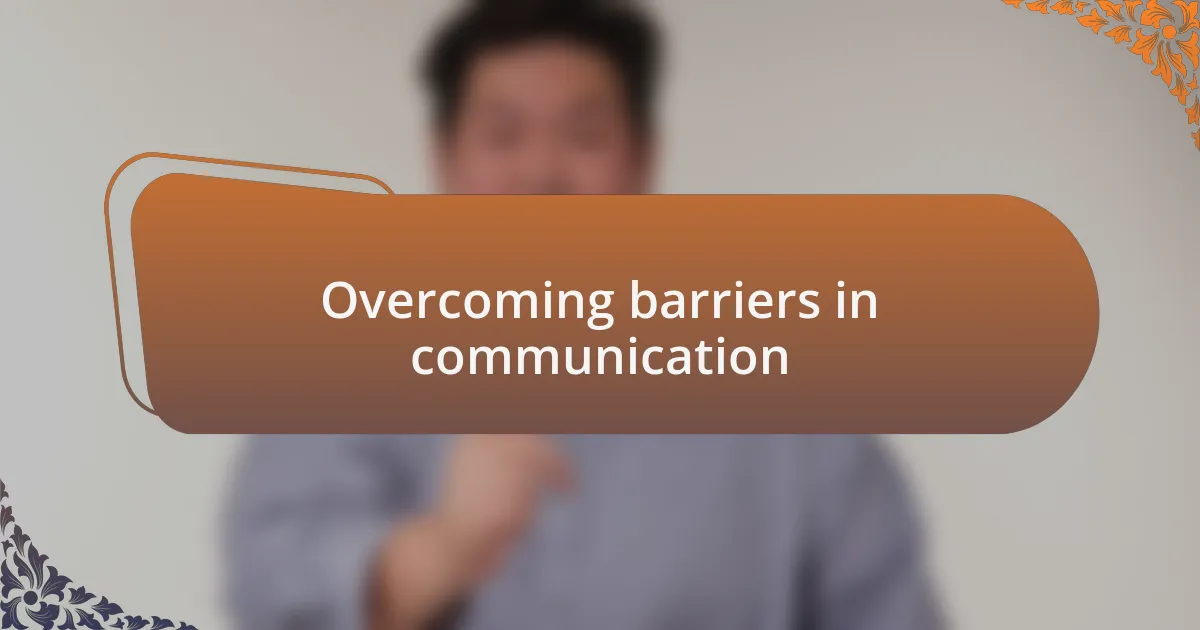
Overcoming barriers in communication
Overcoming barriers in communication often requires us to step outside our comfort zones. I remember a time at a family gathering when I wanted to join a conversation but felt frozen by anxiety. Instead of waiting for the right moment, I decided to approach a cousin I felt comfortable with and simply asked for her opinion on a topic. That one question not only broke the ice for me but also opened the door for others to join in, illustrating how asking for input can transform interaction dynamics.
There are moments when it feels like I’m on the outside looking in, especially during group discussions. At a school club meeting, I noticed some members were hesitant to share their ideas. Instead of feeling defeated, I spoke up and suggested that we write our thoughts on sticky notes to share later. To my surprise, this approach invited everyone to contribute without the pressure of speaking up immediately, showing me that creative solutions can ease tensions and foster inclusivity.
Throughout my journey, I’ve realized that practicing patience can be a powerful tool in overcoming communication barriers. I have a close friend who often finds it hard to express himself verbally, so I’ve learned to wait silently during our conversations. This simple act of allowing space for his thoughts has only strengthened our friendship. Have you found that giving others the time they need to articulate their feelings can lead to deeper connections? It’s remarkable how patience transforms our interactions, creating an environment where everyone feels valued.
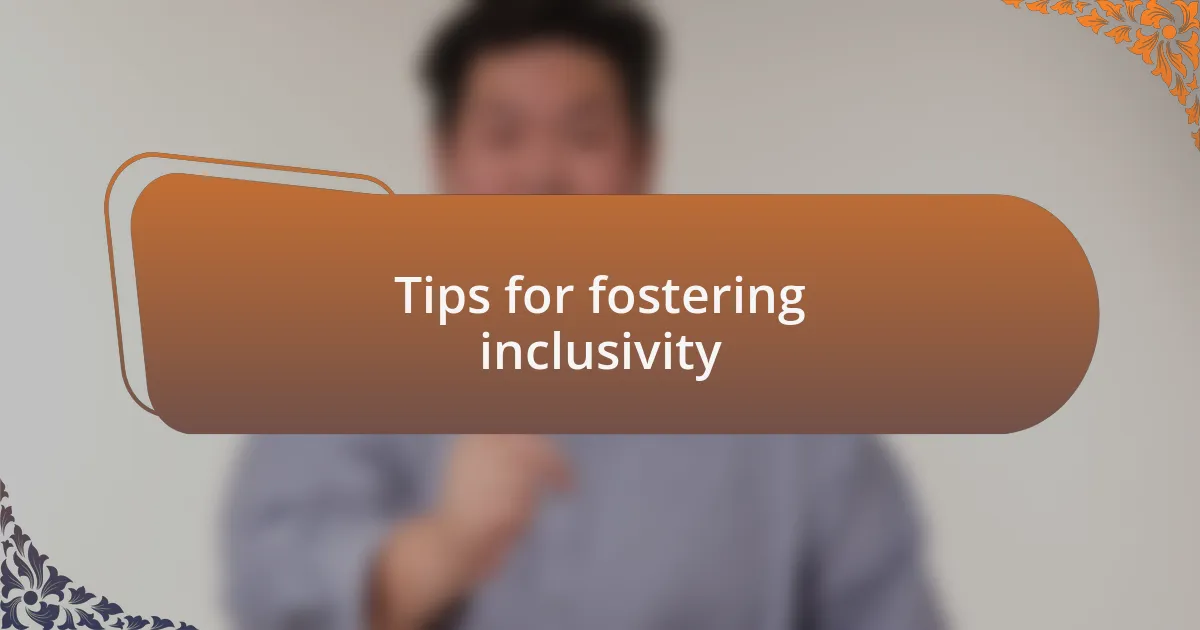
Tips for fostering inclusivity
Creating an inclusive environment begins with mindfulness about the diverse ways people communicate. I vividly recall a time during a collaborative project when one of our team members preferred to express his ideas through drawings rather than words. By encouraging him to display his thoughts visually, we were able to incorporate his unique perspective, demonstrating how embracing different forms of expression can enrich group dynamics. How many incredible insights might we miss if we overlook alternative communication styles?
One effective strategy I’ve found is to establish ground rules for discussions that prioritize respect and active listening. In a discussion I facilitated, I introduced a simple guideline: everyone takes turns sharing their thoughts without interruptions. This approach not only eased the nerves of quieter participants but also allowed for a richer, more meaningful exchange of ideas. Have you ever noticed how simply pausing to let others speak can create a genuine atmosphere of inclusivity?
Engaging in regular check-ins with peers can also foster a sense of belonging. I remember implementing a weekly check-in during our study group, where everyone got a chance to share how they were feeling, both academically and personally. This practice cultivated a space where members felt supported and validated, reinforcing the idea that inclusivity isn’t just about allowing voices to be heard but ensuring those voices are valued and respected. How might your own group benefit from such intentional moments of connection?